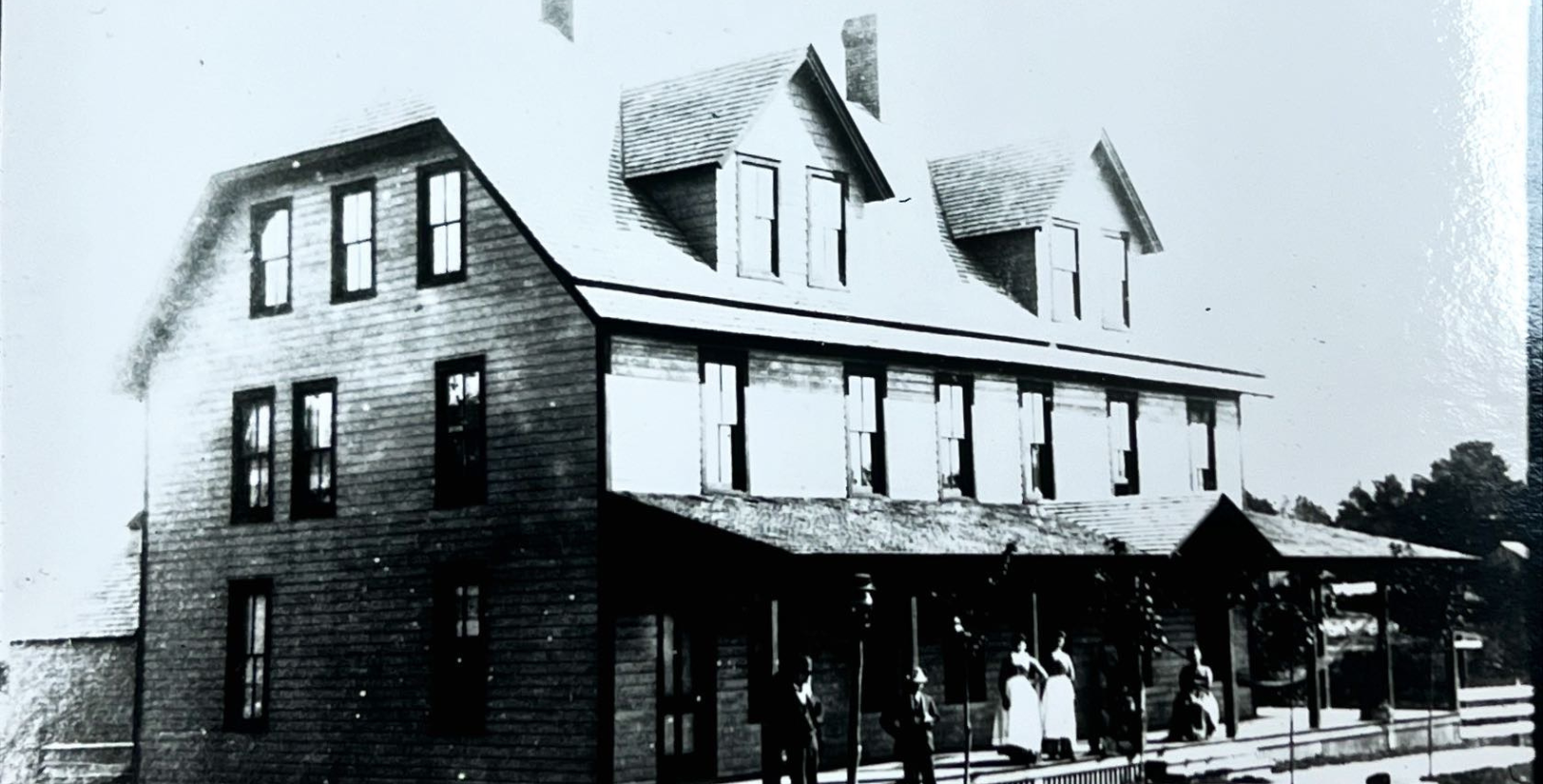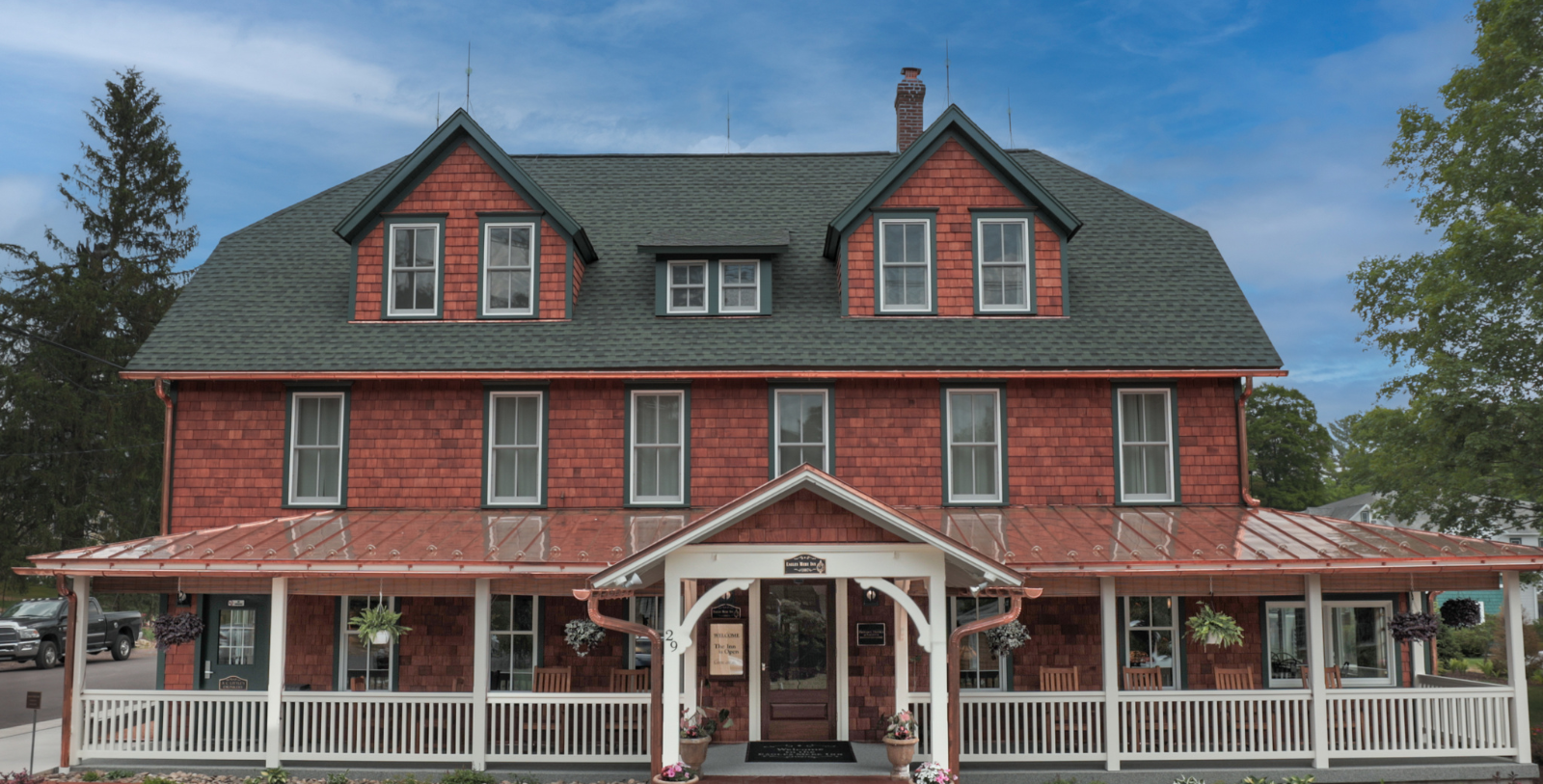Receive for Free - Discover & Explore eNewsletter monthly with advance notice of special offers, packages, and insider savings from 10% - 30% off Best Available Rates at selected hotels.
history
Discover Eagles Mere Inn, which was originally designed by architect Albert Canover Little.
Eagles Mere Inn, a member of Historic Hotels of America since 2021, dates back to 1887.
VIEW TIMELINEA member of Historic Hotels of America since 2021, the Eagles Mere Inn has stood as a cherished local landmark in downtown Eagles Mere, Pennsylvania, for well over a century. The inn was originally built by Albert Canover Little, a talented local architect who spent most of his life being referred to as “A.C.” Born on April 10, 1836, in neighboring Bradford County, he had apprenticed as a carpenter before moving to a place called Picture Rocks. A.C. Little married Margaret E. Phillips and built a house on land owned by her father in the hamlet. A few years later when they divorced, it was rumored that A.C. Little was given an ultimatum to either move the house off his ex-father-in-law’s land or have the home demolished. Oral tradition stipulates that he went with the former option, moving the building to its current spot along Mary Avenue. (Interestingly, the home was used as the town's movie theater until the Great Depression. The home is currently owned by a great-great-great grandson, and even still has the projection room on the second floor.)
A.C. Little was drawn to the Eagles Mere area because of his deep interest in building seasonal cottages within the picturesque landscape of Sullivan County. At the behest of a company of local hoteliers known as the “Eagles Mere Syndicate,” Little and his sons proceeded to build 16 homes throughout Eagles Mere from 1885 to 1906. Little’s work was part of a much larger communal project, in which the Eagles Mere Syndicate had overseen the rebirth of Eagles Mere as a prominent resort town. Among the many buildings that the conglomerate created were a series of massive grand hotels that resided around Eagles Mere Lake. But A.C. Little initially wanted nothing to do with the hotel construction, though, due to the great disturbances that their development caused to the area’s natural beauty. Nevertheless, he decided to help the businessmen create additions onto their grand hotels when it became clear that his normal architectural endeavors would not be enough to support his family.
Amid his ongoing construction projects, A.C. Little purchased a plot of land across the street from his new downtown home in the autumn of 1887. He then proceeded to build the “Hotel Lewis,” a quaint boarding house designed with colonial American design elements. Little’s business subsequently served as the antithesis to the larger hotels scattered about Eagles Mere, offering generous rates for those who wished to avoid paying the grandiose prices offered by the Eagles Mere Syndicate. In fact, many of the construction workers that helped build those same buildings often stayed at the Hotel Lewis because of its affordability. Despite the business rivalries that the grand hotels represented, the Hotel Lewis nonetheless endured for many generations to come. It still managed to attract all kinds of clients over the following decades, even as the other hotels had disappeared by the end of the 20th century. Now known as the “Eagles Mere Inn,” this fantastic holiday destination is proud to continue offering the same outstanding services that have since made it a staple in northeastern Pennsylvania.
-
About the Location +
Once called “Walpaleechen,” Eagles Mere Lake was once frequented often by Iroquois Indians. In 1681, King Charles II of England gave William Penn a large tract of land around the lake, and his heirs subsequently sold off sections to interested investors. Wealthy Englishman George Lewis eventually bought both the lake and over 10,000 surrounding acres in 1800. He bought it as part of a scheme to produce glass from the lake's natural white sand (the body of water would soon become known as “Lewis Lake"). Unfortunately for Lewis, his glass industry did not survive for long and shut down permanently. But in the late 1870s, the area was promoted by prominent Philadelphia judge John Richter Jones as an ideal vacation spot to his friends in the “Main Line.” A few entrepreneurs followed suit and began constructing boarding houses near the majestic Eagles Mere Lake. Soon thereafter in 1885, a group of four businessmen—Robert Allen, James Gamble, John R.T. Ryan, and Benjamin Welch—began purchasing large plots of land around the lake via their conglomerate, the “Eagles Mere Syndicate.” The men specifically hoped to develop the coastline into a magnificent resort community. Inspired by similar towns in places like New York, Florida, and California, the owners of the Eagles Mere Syndicate began constructing numerous cottages for sale. Several local architects designed the structures at the behest of the syndicate, namely A.C. Little and his son, Frank. Soon enough, many wealthy families from Philadelphia, Williamsport, Harrisburg, and even Washington D.C. started purchasing the cottages in droves. With demand for accommodations strong, the Littles continued to construct many more structures throughout Eagles Mere over the next couple of decades.
Several major hotels quickly opened around Eagles Mere Lake, too, which were among the most unique in Pennsylvania at the time. In fact, one of the major hotels in the area, the Forest Inn, originally opened as a Chautauqua camp in 1896, before its conversion into a regular hotel a few years later. But the local tourism industry proved to be so potent that several smaller hotels debuted in downtown Eagles Mere, as well. Among the most notable were the Flora Villa Inn and the Hotel Lewis, which displayed the rare blend of revivalist architectural styles. All the hotels—big and small alike—created a magnificent culture based on fun and relaxation that generations of Americans experienced for years thereafter. Arriving by way of the Eagles Mere Railway, guests staying at any one of the hotels could participate in countless activities that ranged from adventurous hikes to steamboat tours Eagles Mere Lake. Unfortunately, the prosperity of Eagle Mere’s historic tourist economy came to an end in the mid-20th century. National popularity with the resort community diminished significantly in the years following World War II, leading to the closure of the many luxurious holiday destinations that ringed the lake. By the late 1980s, nearly every single one of the town’s Grand Dames had closed for good. Thankfully, the Hotel Lewis managed to survive the culling and was even reborn as the brilliant “Eagles Mere Inn” several years later. Today, Eagles Mere has since returned to being an incredibly attractive vacation getaway, with travelers visiting annually from all around the world. Much of the historic downtown is even preserved as a historic district, which the U.S. Department of the Interior has listed in the U.S. National Register of Historic Places.
-
About the Architecture +
The Eagles Mere inn originally debuted centuries ago as a magnificent three-story boarding house outfitted with Colonial Revival-style architecture. Its façade facing the main road measured six bays wide and featured a porch that ran the entire length of the building. Furthermore, A.C. Little topped the gorgeous structure with two large gabled dormers on the third floor, which blended terrifically with a hip-on-gable rooftop. Not much has changed since the inn first opened centuries ago, too, in spite of many renovations that have since taken place on-site. For instance, watercolor paintings once covered the walls, and a fireplace was added to the bar and entertainment area. Modern fire escapes were installed as well, and many surfaces have been continuously refurbished to keep up the quality of the inn. One of the greatest construction projects to occur transpired back in 1957. Construction crews specifically dug out the entire basement, leaving a foundation for the future bar and dining area.
Since 2017 the Inn has undergone a few major renovations. Below the Pub in the basement, seven natural springs were discovered flowing beneath the concrete floor. After significant work with jackhammers, pumps, and holding tanks- the Inn was again structrually sound. In 2023 the exterior of the Inn was refurbished with cedar shingles, a copper roof and new windows that still manage to maintain the traditional architecture of the Colonial Revival era.
Colonial Revival architecture itself is perhaps the most widely used building form in the entire United States today. It reached its zenith at the height of the Gilded Age, where countless Americans turned to the aesthetic to celebrate what they feared was America’s disappearing past. The movement came about in the aftermath of the Centennial International Exhibition of 1876, in which people from across the country traveled to Philadelphia, Pennsylvania, to commemorate the American Revolution. Many of the exhibitors chose to display cultural representations of 18th-century America, encouraging millions of people across the country to preserve the nation’s history. Architects were among those inspired, who looked to revitalize the design principles of colonial English and Dutch homes. This gradually gave way to a larger embrace of Georgian and Federal-style architecture, which focused exclusively on the country’s formative years.
As such, structures built in the style of Colonial Revival architecture featured such components as pilasters, brickwork, and modest, double-hung windows. Symmetrical designs defined Colonial Revival-style façades, anchored by a central, pedimented front door and simplistic portico. Gable roofs typically topped the buildings, although hipped and gambrel forms were used, as well. This building form remained immensely popular for years until largely petering out in late-20th century. Nevertheless, architects today still rely upon Colonial Revival architecture, using the form to construct all kinds of residential buildings and commercial complexes. Many buildings constructed with Colonial Revival-style architecture are even identified as historical landmarks at the state level, and the U.S. Department of the Interior has even listed a few of them in the U.S. National Register of Historic Places. (The Eagles Mere Inn is one such building, which feature a listing as part of the Eagles Mere Historic District.)

































